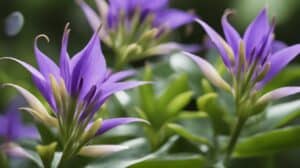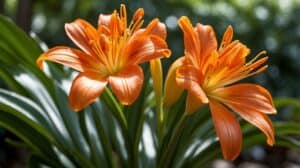Chenille plants, also known as Acalypha hispida, are a popular houseplant due to their fluffy, vibrant blooms that resemble a caterpillar.
They are native to the Pacific Islands and Southeast Asia, and are relatively easy to care for.
However, many people are unaware of the specific care requirements necessary to keep these plants thriving.

To ensure your chenille plant remains healthy and vibrant, it is important to understand its needs.
This includes providing it with the proper lighting, watering, and fertilization.
Additionally, it is important to be aware of common pests and diseases that can affect chenille plants, and how to prevent and treat them.
By following these guidelines, you can enjoy the beauty of your chenille plant for years to come.
Getting to Know Your Chenille Plant
Species Overview
The Chenille plant, also known as Acalypha hispida, is a tropical shrub that belongs to the Euphorbia family.
This plant is native to the Pacific Islands, Malaysia, and the Philippines.
It is a beautiful ornamental plant that produces long, fluffy, and fuzzy red flowers that resemble caterpillars.
Distinctive Features
The Chenille plant is a fast-growing shrub that can reach up to 6 feet in height and 3 feet in width.
It has a woody stem and oval-shaped leaves that are dark green in color. The leaves can grow up to 6 inches long and 3 inches wide.
The Chenille plant is a low-maintenance plant that can thrive in a variety of conditions.
One of the most distinctive features of the Chenille plant is its long, fuzzy, and red flowers.
These flowers can grow up to 18 inches in length and have a velvety texture.
The flowers bloom all year round, but they are most abundant during the summer months.
Another unique feature of the Chenille plant is its ability to attract butterflies and hummingbirds.
The flowers of the Chenille plant are rich in nectar, which makes them a favorite of these pollinators.
Overall, the Chenille plant is a beautiful and unique addition to any garden or indoor space.
With proper care, it can thrive and produce its distinctive caterpillar-like flowers for many years to come.
Essential Care Guidelines

Lighting Needs
The Chenille Plant (Acalypha hispida) requires bright, indirect light to thrive.
It is best to place the plant near a window that receives filtered sunlight for at least six hours a day.
Direct sunlight can scorch the leaves, so it is essential to avoid placing the plant in direct sunlight.
Watering Practices
The Chenille Plant requires regular watering to keep the soil moist but not waterlogged.
It is best to water the plant when the top inch of soil feels dry to the touch.
Overwatering can lead to root rot, so it is essential to avoid letting the plant sit in standing water.
Soil and Fertilization
The Chenille Plant requires well-draining soil that is rich in organic matter. A mixture of peat moss, perlite, and vermiculite is ideal.
It is also essential to fertilize the plant regularly during the growing season with a balanced fertilizer.
Temperature and Humidity
The Chenille Plant prefers warm temperatures between 60°F to 80°F.
It is essential to avoid exposing the plant to temperatures below 50°F as it can cause damage to the leaves.
The plant also requires high humidity levels, so it is best to place a humidifier near the plant or mist the leaves regularly.
Remember to keep these essential care guidelines in mind when caring for your Chenille Plant to ensure it stays healthy and beautiful.
Propagation and Growth

Propagation Techniques
Chenille plants can be propagated through stem cuttings or by layering. Stem cuttings are the most common method of propagation.
To propagate through stem cuttings, select a healthy stem that is at least 4 inches long and has several leaves.
Cut the stem just below a node and remove the leaves from the lower half of the stem.
Dip the cut end in rooting hormone and plant it in a well-draining potting mix. Keep the soil moist and place the pot in a bright, warm location.
The cutting should root in about 4-6 weeks.
Layering is another propagation method that involves burying a stem of the plant while it is still attached to the parent plant.
To do this, select a stem that is long enough to reach the soil. Make a small cut in the stem where it touches the soil and secure it with a U-shaped wire.
Cover the cut portion with soil and keep it moist. After a few weeks, roots will form and the new plant can be separated from the parent plant.
Growth Expectations
Chenille plants are fast-growing and can reach up to 6 feet in height. They prefer bright, indirect light and well-draining soil.
The plant should be fertilized every 2-3 months with a balanced fertilizer. Chenille plants are prone to root rot, so it is important not to overwater them.
Allow the soil to dry out slightly between waterings.
During the growing season, chenille plants produce long, fuzzy red or pink flowers that resemble caterpillars.
These flowers can last for several weeks and add a unique texture to the plant. To promote flowering, pinch back the tips of the plant in early spring.
This will encourage the plant to produce more lateral branches and more flowers.
Common Issues and Solutions

Pest Management
Chenille plants are susceptible to pests such as spider mites, scale insects, and mealybugs.
These pests can damage the plant by feeding on its leaves and sucking out its sap.
To prevent pest infestations, it is important to regularly inspect the plant and take action immediately if any pests are found.
One effective way to manage pests is to use a gentle soap solution to wash the plant’s leaves.
This can be done by mixing a few drops of dish soap with water and spraying it onto the plant.
Another option is to use a neem oil spray, which is a natural insecticide that can be found at most garden centers.
If the pest infestation is severe, it may be necessary to use a stronger insecticide.
However, it is important to read the label carefully and follow the instructions to avoid harming the plant.
Disease Prevention
Chenille plants are also susceptible to diseases such as root rot, powdery mildew, and leaf spot.
These diseases can be caused by overwatering, poor air circulation, and high humidity levels.
To prevent these diseases, it is important to ensure that the plant is not overwatered and that the soil is well-draining.
It is also important to provide adequate air circulation by placing the plant in a well-ventilated area.
If the plant does develop a disease, it is important to take action immediately to prevent it from spreading.
This can be done by removing any infected leaves or stems and applying a fungicide to the plant.
It is also important to isolate the infected plant to prevent the disease from spreading to other plants.
Frequently Asked Questions

What are the ideal lighting conditions for a Chenille Plant?
Chenille Plants thrive in bright, indirect sunlight. They can also tolerate some direct sunlight in the morning or late afternoon.
However, too much direct sunlight can scorch the leaves. If your Chenille Plant is not getting enough light, its leaves may turn yellow and drop.
How often should I water my Acalypha hispida?
Chenille Plants prefer moist soil, but they do not like to sit in water. Water your plant when the top inch of soil feels dry to the touch.
During the growing season, you may need to water your Chenille Plant once or twice a week.
In the winter months, you can reduce watering to once every two weeks.
Are Chenille Plants safe for pets?
Chenille Plants are considered toxic to pets and humans if ingested. Keep your plant out of reach of pets and children.
What should I do to maintain the vibrant red flowers of my Chenille Plant?
Chenille Plants produce their signature red flowers in the summer months.
To encourage blooming, fertilize your plant with a balanced fertilizer every two weeks during the growing season.
Deadhead spent flowers to promote new growth and more blooms.
Where can I purchase a healthy Chenille Plant?
You can purchase Chenille Plants at your local nursery or garden center. You can also find them online from reputable sellers.
Look for plants with healthy foliage and no signs of pests or disease.
Can you provide tips for propagating a Chenille Plant?
Chenille Plants can be propagated from stem cuttings. Take a 4-6 inch cutting from a healthy plant and remove the lower leaves.
Dip the cut end in rooting hormone and plant it in a pot filled with moist soil.
Keep the soil moist and the cutting in bright, indirect light until it roots and begins to grow.














